Decorating
Plan Your Wardrobe for the Real World
Find out how to store all your clothes, shoes and accessories in easy-to-access style, without blowing the budget
As a professional organiser, one of my biggest frustrations is that a poorly-designed wardrobe costs the same as a well-designed wardrobe – it’s how you design and use the space and the storage options that will give you the biggest bang for your buck. If you’re starting with a clean slate, this guide will help you decide what to build, what to store and how to get the most out of every centimetre of space.
By being that specific, in this wardrobe I have managed to squeeze in an extra drawer between the double hanging sections, as well as some handy shelves.
TIP: Hang the top rod high enough so you have enough space between the bottom of the hanging clothes and the second rod underneath.
TIP: Hang the top rod high enough so you have enough space between the bottom of the hanging clothes and the second rod underneath.
Focus on ergonomics
Nobody wants to crawl on the floor to find their summer shorts, and who can be bothered bending low to put bags or scarves on a shelf at knee height? Design your space more ergonomically and you’ll notice things are far easier to find. And it will be much easier to keep your wardrobe tidy too.
Positioning shelves above the hanging space is a smart move ergonomically, and making your shelves only 360mm deep ensures you won’t lose things at the back. Space the shelves only 250mm apart and things won’t migrate to the never never; you can stack right to the top of the shelf because there’s no need to reach to the back. Do it this way and you’ll hardly ever need to reorganise your wardrobe – things have nowhere to go.
TIP: Shelf widths at 300mm increments are best because folded clothes average 300mm across and 360mm deep.
Nobody wants to crawl on the floor to find their summer shorts, and who can be bothered bending low to put bags or scarves on a shelf at knee height? Design your space more ergonomically and you’ll notice things are far easier to find. And it will be much easier to keep your wardrobe tidy too.
Positioning shelves above the hanging space is a smart move ergonomically, and making your shelves only 360mm deep ensures you won’t lose things at the back. Space the shelves only 250mm apart and things won’t migrate to the never never; you can stack right to the top of the shelf because there’s no need to reach to the back. Do it this way and you’ll hardly ever need to reorganise your wardrobe – things have nowhere to go.
TIP: Shelf widths at 300mm increments are best because folded clothes average 300mm across and 360mm deep.
Give drawers a miss
Drawers add significantly to the price of a built-in wardrobe, restrict the layout, and waste space. Be resourceful with your space instead – if you already have a chest of drawers or bedside tables in the room, perhaps that’s all you need for underwear and socks. Jumpers and t-shirts are best placed on open shelves where you can see them easily.
Drawers add significantly to the price of a built-in wardrobe, restrict the layout, and waste space. Be resourceful with your space instead – if you already have a chest of drawers or bedside tables in the room, perhaps that’s all you need for underwear and socks. Jumpers and t-shirts are best placed on open shelves where you can see them easily.
Add storage elsewhere
When you have a small space, the trick is using every bit of storage fully. I often achieve this by not having anything in the wardrobe but clothes for hanging. There’s little point in storing folded clothes in deep wardrobe shelves – it ends up a mess. Instead, use deep space for hanging clothes, then put folded clothes and shoes elsewhere.
In my son’s room, pictured here, we have deep drawers under the bed for shoes and sports gear. This is great because he can just dump them in and then see them easily when he needs them again (although apparently not as easily as he can see them on the floor!) This is a much better option than storing these items at the bottom of a wardrobe or under the bed.
See more of this bedroom
When you have a small space, the trick is using every bit of storage fully. I often achieve this by not having anything in the wardrobe but clothes for hanging. There’s little point in storing folded clothes in deep wardrobe shelves – it ends up a mess. Instead, use deep space for hanging clothes, then put folded clothes and shoes elsewhere.
In my son’s room, pictured here, we have deep drawers under the bed for shoes and sports gear. This is great because he can just dump them in and then see them easily when he needs them again (although apparently not as easily as he can see them on the floor!) This is a much better option than storing these items at the bottom of a wardrobe or under the bed.
See more of this bedroom
Get smart with your shoes
If space is tight, storing all your shoes in the wardrobe may not be possible. If you can fit them in, however, aim to stash them on shelves at mid-height so you can see them.
Whether you choose regular shelves, slide-out shelves or drawers, there’s no need to give shoes too much room to move – they’re usually only 300mm deep and will slot into some pretty tight places.
This drawer method allows you to use the full depth of the wardrobe, and makes shoes easy to see and access.
If space is tight, storing all your shoes in the wardrobe may not be possible. If you can fit them in, however, aim to stash them on shelves at mid-height so you can see them.
Whether you choose regular shelves, slide-out shelves or drawers, there’s no need to give shoes too much room to move – they’re usually only 300mm deep and will slot into some pretty tight places.
This drawer method allows you to use the full depth of the wardrobe, and makes shoes easy to see and access.
If you can’t fit shoes in the wardrobe, a shallow, purpose-built cabinet can do the job instead.
10 genius shoe storage hacks
10 genius shoe storage hacks
Don’t waste your money on ‘clever’ accessory storage
Storage devices for accessories can be useful, but be selective – if a gadget involves more than one action to perform its role, you’ll likely get sick of it. I find most wardrobe accessories are a waste of money and space in a small wardrobe.
What does work well are racks for belts, ties and scarves, which slide in and out. Or if you don’t mind things flapping on the back of a hinged door, you can also install racks there.
Storage devices for accessories can be useful, but be selective – if a gadget involves more than one action to perform its role, you’ll likely get sick of it. I find most wardrobe accessories are a waste of money and space in a small wardrobe.
What does work well are racks for belts, ties and scarves, which slide in and out. Or if you don’t mind things flapping on the back of a hinged door, you can also install racks there.
Go for flexibility
The great thing about this wardrobe is that the hanging rods insert into the same holes as the shelf supports, so you can switch them around as needed. In summer, you could use rods to hang blouses and in winter, pop the shelves in instead to hold jumpers. Store the off-season gear out of the way on the top shelf.
The great thing about this wardrobe is that the hanging rods insert into the same holes as the shelf supports, so you can switch them around as needed. In summer, you could use rods to hang blouses and in winter, pop the shelves in instead to hold jumpers. Store the off-season gear out of the way on the top shelf.
Don’t forget to make use of the rest of the house!
Your bedroom wardrobe doesn’t have to bear the brunt of your whole home’s clutter. Store as much as possible in the utility areas of your home to save on the cost of built-in wardrobes.
A shelving system such as this stores just as much as a standard built-in wardrobe, and for just a fraction of the price. I installed something similar to this in my laundry, instead of putting a built-in wardrobe into a temporary bedroom for my daughter. Now that my daughter has left home, I have excellent versatile storage in the laundry. A wardrobe in an empty room would have been redundant.
This system is easily adjustable, so I can use it for anything and add shelves if needed. Expect to pay $600-$1000 for a set-up like this.
TELL US
Do you have a clever wardrobe organising tip? Share it with us in the Comments.
MORE
9 Genius Clothes Storage Hacks
Storage Solutions That Make Your Guest Bedroom Work Harder
9 Salvaged Cast-Offs Reinvented as Storage
Your bedroom wardrobe doesn’t have to bear the brunt of your whole home’s clutter. Store as much as possible in the utility areas of your home to save on the cost of built-in wardrobes.
A shelving system such as this stores just as much as a standard built-in wardrobe, and for just a fraction of the price. I installed something similar to this in my laundry, instead of putting a built-in wardrobe into a temporary bedroom for my daughter. Now that my daughter has left home, I have excellent versatile storage in the laundry. A wardrobe in an empty room would have been redundant.
This system is easily adjustable, so I can use it for anything and add shelves if needed. Expect to pay $600-$1000 for a set-up like this.
TELL US
Do you have a clever wardrobe organising tip? Share it with us in the Comments.
MORE
9 Genius Clothes Storage Hacks
Storage Solutions That Make Your Guest Bedroom Work Harder
9 Salvaged Cast-Offs Reinvented as Storage




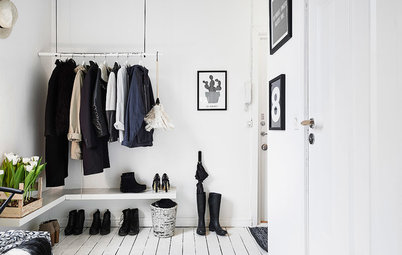
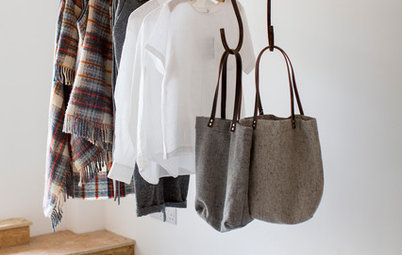
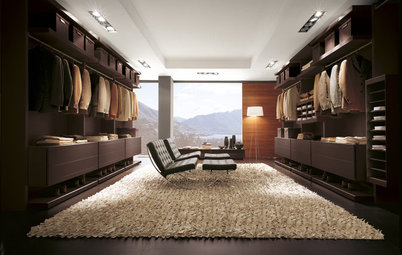
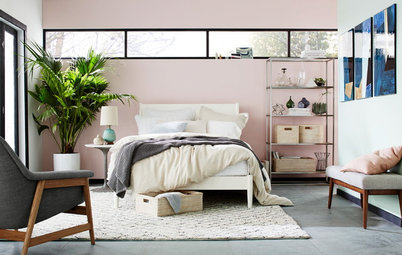
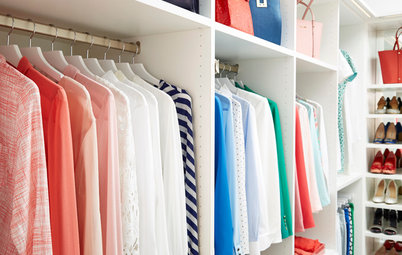
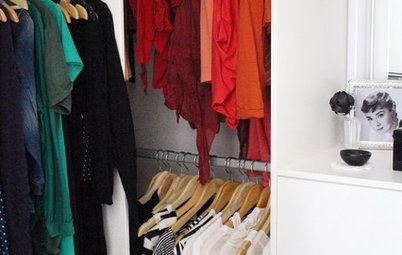
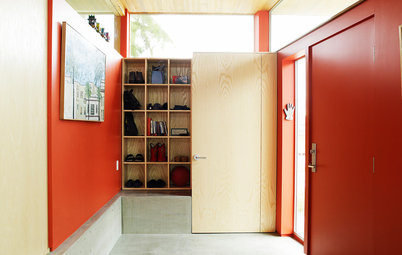
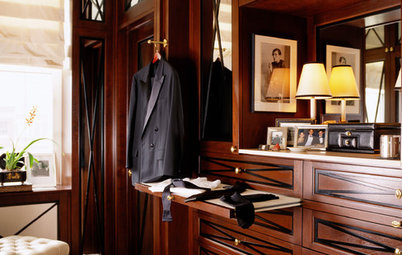
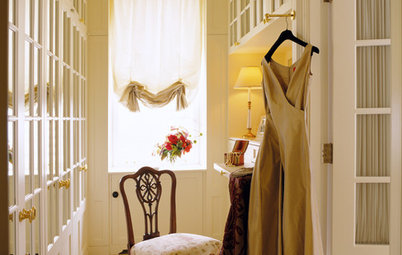
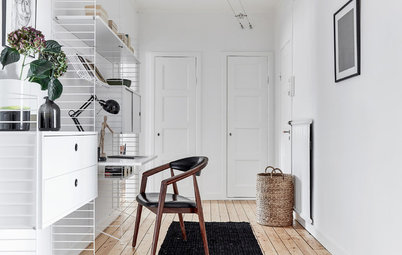
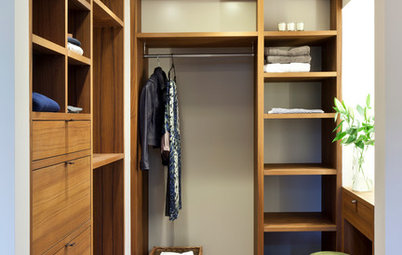
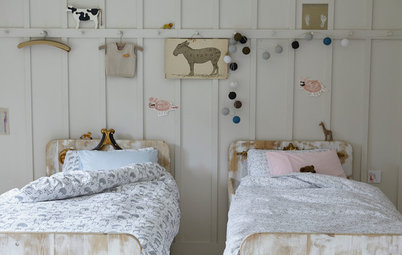
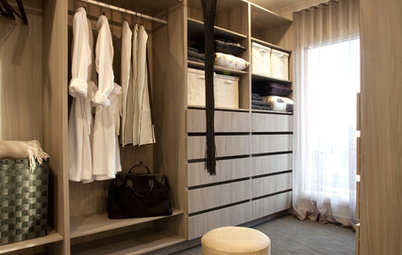
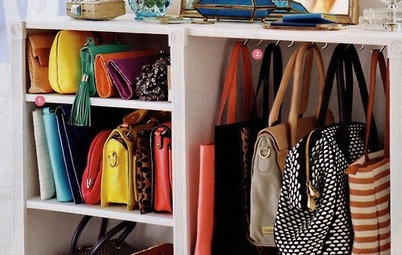
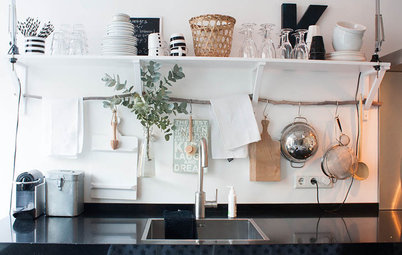
Decide how big or small you need your wardrobe to be before you start on the design. It’s the default thinking of people and wardrobe companies to see a big blank wall and sacrifice it to a wardrobe, without consideration of what its contents will be.
By building your wardrobe based only on how much hanging space you actually need, even a small bedroom can retain a feeling of spaciousness, with room leftover for a large bed, a desk and maybe more. You can also end up spending less than half the money you would if you opted for a full-wall wardrobe, which you may not need.